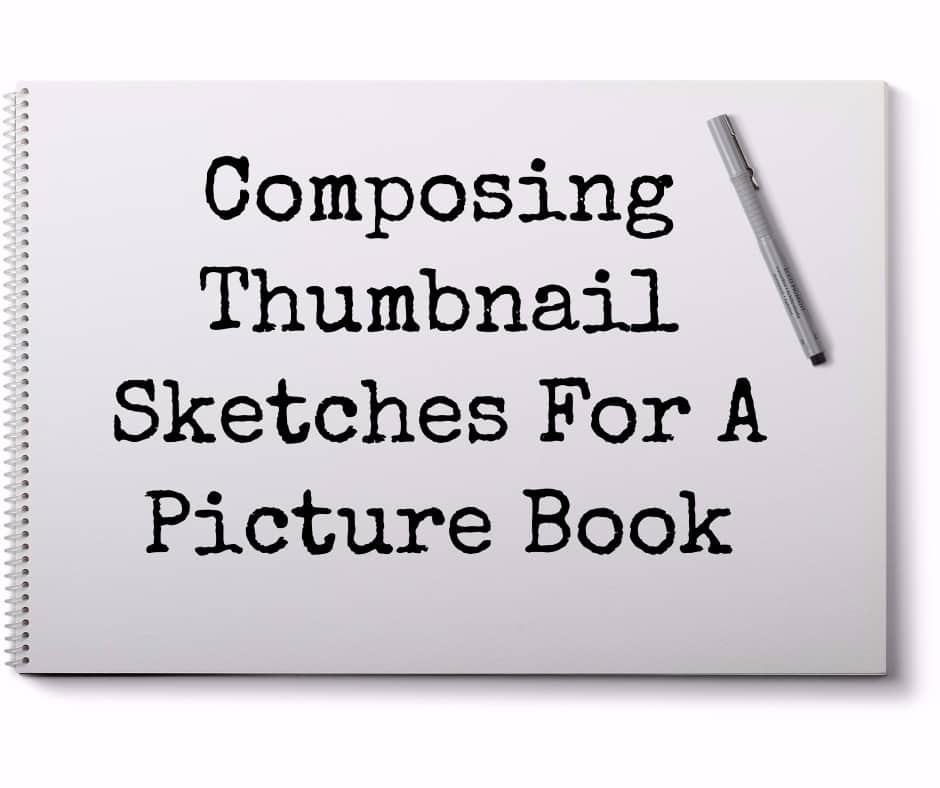How do you go about the task of mocking up a picture book? Most picture book illustrators make a dummy of thumbnails, to check the story flows well. Many writers (who are not also illustrators) find this a helpful practice, too.
The following notes are from Framed Ink: Drawing and composition for visual storytellers by Marcos Mateu-Mestre (2010) and various other sources such as Reading Contemporary Picturebooks by David Lewis (2001).
- When composing a piece, decide first which part of the picture you would like the audience to see first.
- To draw attention to something, make it bigger, and if it’s not actually bigger, position it closer to the camera.
- We tend to look towards a vanishing point. So you can position important things there.
- The audience tends to look in the same direction as the main character, assuming something relevant is going on in that direction.
- For English-background readers, we are used to reading from left to right. If the action is going in that direction we’ll feel more at ease. If the action is going from right to left we’ll feel something’s not quite right: hard times and difficulty.
- Decide on the emotion you want to evoke, and its intensity. (Sadness, happiness, action, suspense?)
- The execution of the artwork — the style — must suit the type of story being told.
- In visual storytelling, looking great is not enough. Each work of art (frame) must help to propel the story along. Something which is simply beautiful may pull the viewer out of the story. [I think now of Hayao Miyazaki’s Spirited Away, in which some scenes are not vital to the plot but exist only for world-building and atmosphere. This is important too.]
- Is there anything that can be left out without changing what you want to say?
- The first shots will establish the milieu and emotional landscape. This must remain consistent until the final frame.
- To build atmosphere manipulate lighting, pacing and colour.
- Give the audience the opportunity to create their own reality as much as possible, by creating a gap between the visuals and the text. When answering a question, raise another at the same time.
- Simplicity, shadows and silences are sometimes more important than detail. Leave the reader wondering about something.
- Where to position the ‘camera’? Looking up/straight on/from above/from some other weird angle?
- Naturalistic perspective, flattened or exaggerated?
- We look at things depending on what we’re focused on at the moment. [So if there was a hint of a gun in one frame, we’ll be expecting to see it, and therefore focused on it, in the following frame.]
- Curved shapes = subtle/peaceful.
- Diagonal lines = dynamic/aggressive.
- Straight lines = assertiveness.
- Avoid weird coincidences, like a tree growing out of a head just because someone happens to be standing in front of a tree.
- When cutting in closer to a scene, there is a rule to be followed, to do with proportions. Keep the subject at the same position in both frames so the reader knows it’s the same subject and not a different one.
- To make an image seem deeper, create an uneven balance of shapes — big to small.
- To better convey the direction of action in action scenes, make the action follow the lines of perspective.
- To establish intimacy between two characters, clear the space between them. To create antagonism, put obstacles between them. (Or make use of light and darkness/background shapes.)
- High and low, right and left are all locations that can have significance. Figures positioned up high may be interpreted as in ecstatic or dream-like states, or may have high social status or a positive self-image.
- On pages where pictures are mere vignettes or are only partially framed so that the words push in from the side, or where pictures are irregularly sequenced down or across the page in asymmetrical arrangements, then high and low, left and right have no significant value.
- When studying picturebooks closely, positional codes are used relatively sparingly [when compared to comics and graphic novels].
- More common in picturebooks: the convention that places figures in motion facing left to right. Any character attempting to move from right to left will be perceived as interfering with the natural course of events: they’ve returned from an adventure/blocking someone’s path/have sinister intentions etc.
- Children are remarkably quick to take in a scene, even in cases where the illustration is not particularly ept, and interpreting that scene as intended, but there are certain features of visual images that are harder for children to understand: anything which has a meaning over and above what is represented. Children may or may not understand, for instance, that a red cross indicates medical assistance, depending on their age and cultural background.
SEE ALSO
Character Relations In Picturebooks

